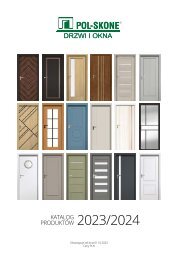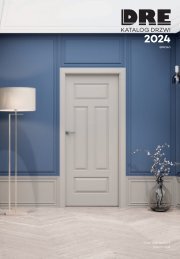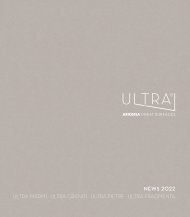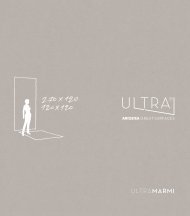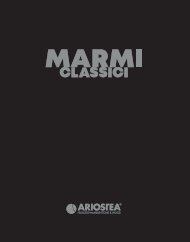You also want an ePaper? Increase the reach of your titles
YUMPU automatically turns print PDFs into web optimized ePapers that Google loves.
MOUNTING
Make sure the mounting of the radiators on the wall or floor is performed with the use of appropriate screws, bolts, pins etc. properly
selected for the type of surface. Screws and bolts provided by the radiator manufacturer are not suitable for all kinds of walls and
floors. To seal the connections between the radiator and the fittings always use materials resistant to the conditions present in the
central heating system.
The radiator should be placed in the coldest area of the room. Most frequently, the outside walls by the window are a natural
selection. To make the most of the radiators’ heat output avoid mounting them in places where they will be covered by other
elements and equipment e.g.: furniture, heavy curtains, TV’s, kitchen appliances etc. The spacing between the edges of the radiator
and the nearest surfaces (floor, window sill) should not be smaller than 100 mm.
Connection through valves working with thermostatic heads makes it possible to maintain the ambient temperature at a desired
level in the range possible to achieve with the radiator’s heat output.
Thermostatic regulation ensures higher cost-effectiveness of the central heating system and increases the thermal comfort in the
room.
Moreover, the use of valve sets or multi-valves offers the possibility to cut off the radiator completely when replacing it without the
need to drain the whole central heating system.
SUMMARY
WHEN SELECTING RADIATOR TYPE AND SIZE YOU SHOULD CONSIDER:
• • radiator type and intended purpose (e.g. as extra heat source – towel rail)
• • kind of room (bathroom, living room, hall)
• • required heat demand in the room (preferably calculated by a specialist)
• • level of temperature that we want to achieve in the room
• • calculation parameters of the system water
- feed and return water temperature
- maximum parameters of the water in the system
- max temperature
- max pressure
• radiator size based on its heat output and placement in the room
• connection configuration – the need to use a particular type of connection to the system (e.g. top-bottom, bottom)
• possibility to use extra accessories (e.g. electric heating element, hanger, mirror)
• radiator design and colour.
151
NOTES ON SAFE USE OF CENTRAL HEATING RADIATORS
• The product should be used accordingly to its designed purpose, applying appropriate assembly and exploitation
rules included in the documentation provided with the product.
• The radiator is not a load-bearing structure. Avoid stepping on it, or using it as a ladder. Such practices can result
in damaging the construction, lack of leakproofness of the radiator connections, or tearing of the fixing elements
leading to falling down or scalding with hot water.
• The radiator should not serve as a railing or hold as it is not its designed purpose.
• Remember that the radiator is fed with water of changeable temperature depending on the source of heat. The
temperature of water can exceed 90OC. Touching the hot radiator can result in burns or scalds, therefore keep hot
radiators out of reach of small children.
• While bleeding the radiator, mind the direction in which the bleed valve points to avoid dribbling of hot water on
the person carrying out the bleeding. In some cases the use of special protective covers is recommended.
• In case of discovering leakages near connections to the system, or near the housing of the radiator, immediately
shut off all existing valves to disconnect the radiator from the system, then correct the fault.
• In case of using electric heating elements inserted into the radiator connected to the central heating system,
make sure the radiator is filled with water prior to switching the heating element on. To perform a check of the
filling of radiator, turn the bleed valve slightly – if water appears, the radiator is ready to work with the electric
element.
• Prior to switching on the electric heating element installed in the radiator connected to the central heating
system, shut off the feeding valve, and the return valve (if available) should be open. The radiator must necessarily
be filled with water.
• Only heating elements designed for central heating radiators can be used.







